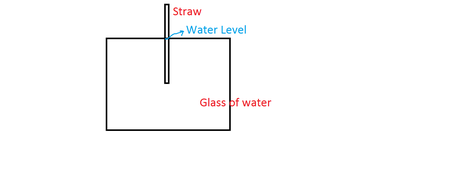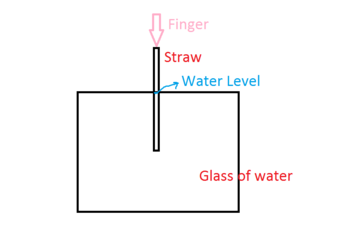Water in a straw
John dips a straw in the water. When he completely takes out the straw, he notices that the gravity pulls out all the water from it.
He again dips the straw in the water. This time he seals the top of the straw by a finger so that air cannot pass through it. He then slowly takes out the straw completely from the water. What change will he observe in the level of the water in the straw?
Details and Assumptions:
- The water sticking to the walls of the straw due to surface tension is neglected.
- The capillary rise is neglected.
This section requires Javascript.
You are seeing this because something didn't load right. We suggest you, (a) try
refreshing the page, (b) enabling javascript if it is disabled on your browser and,
finally, (c)
loading the
non-javascript version of this page
. We're sorry about the hassle.


When we seal the top end of the straw with a finger then the air gets trapped in the upper portion. The trapped air has the pressure equal to the atmospheric pressure that is P 0 . Now, if the straw is taken out then the pressure difference above and below the water is equal and no force is available to carry the weight of the water. Thus, the water in the straw falls down.
However, as the water level falls, the trapped air expands which will result in a decrease in its pressure. This leads to a pressure difference of Δ P across the water column. Eventually, the system will attain an equilibrium where the force due to this pressure difference equals the weight of the water remained in the straw.
Bonus:
Calculate the height up to which the water will remain in the straw. Given the atmospheric pressure is P 0 , the density of water is ρ , the total height of the straw is h and the acceleration due gravity is g . Assume that the temperature of the trapped air remains constant.